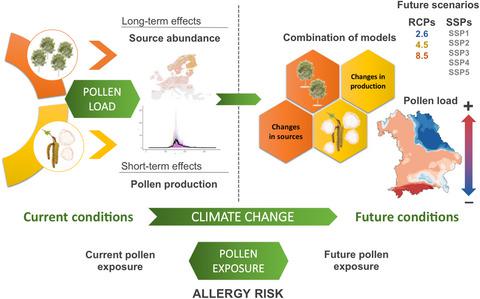当前位置:
X-MOL 学术
›
Glob. Change Biol.
›
论文详情
Our official English website, www.x-mol.net, welcomes your feedback! (Note: you will need to create a separate account there.)
Effects of future climate change on birch abundance and their pollen load
Global Change Biology ( IF 11.6 ) Pub Date : 2021-08-06 , DOI: 10.1111/gcb.15824 Jesús Rojo 1, 2 , Jose Oteros 3 , Antonio Picornell 4 , José M Maya-Manzano 1 , Athanasios Damialis 5, 6, 7 , Katrin Zink 8 , Matthias Werchan 9 , Barbora Werchan 9 , Matt Smith 10 , Annette Menzel 11 , Sabine Timpf 12 , Claudia Traidl-Hoffmann 6, 7 , Karl-Christian Bergmann 13 , Carsten B Schmidt-Weber 1 , Jeroen Buters 1
Global Change Biology ( IF 11.6 ) Pub Date : 2021-08-06 , DOI: 10.1111/gcb.15824 Jesús Rojo 1, 2 , Jose Oteros 3 , Antonio Picornell 4 , José M Maya-Manzano 1 , Athanasios Damialis 5, 6, 7 , Katrin Zink 8 , Matthias Werchan 9 , Barbora Werchan 9 , Matt Smith 10 , Annette Menzel 11 , Sabine Timpf 12 , Claudia Traidl-Hoffmann 6, 7 , Karl-Christian Bergmann 13 , Carsten B Schmidt-Weber 1 , Jeroen Buters 1
Affiliation

|
Climate change impacts on the structure and function of ecosystems will worsen public health issues like allergic diseases. Birch trees (Betula spp.) are important sources of aeroallergens in Central and Northern Europe. Birches are vulnerable to climate change as these trees are sensitive to increased temperatures and summer droughts. This study aims to examine the effect of climate change on airborne birch pollen concentrations in Central Europe using Bavaria in Southern Germany as a case study. Pollen data from 28 monitoring stations in Bavaria were used in this study, with time series of up 30 years long. An integrative approach was used to model airborne birch pollen concentrations taking into account drivers influencing birch tree abundance and birch pollen production and projections made according to different climate change and socioeconomic scenarios. Birch tree abundance is projected to decrease in parts of Bavaria at different rates, depending on the climate scenario, particularly in current centres of the species distribution. Climate change is expected to result in initial increases in pollen load but, due to the reduction in birch trees, the amount of airborne birch pollen will decrease at lower altitudes. Conversely, higher altitude areas will experience expansions in birch tree distribution and subsequent increases in airborne birch pollen in the future. Even considering restrictions for migration rates, increases in pollen load are likely in Southwestern areas, where positive trends have already been detected during the last three decades. Integrating models for the distribution and abundance of pollen sources and the drivers that control birch pollen production allowed us to model airborne birch pollen concentrations in the future. The magnitude of changes depends on location and climate change scenario.
中文翻译:

未来气候变化对桦树丰度及其花粉量的影响
气候变化对生态系统结构和功能的影响将使过敏性疾病等公共卫生问题恶化。桦树(桦木spp.) 是中欧和北欧空气过敏原的重要来源。桦树很容易受到气候变化的影响,因为这些树木对温度升高和夏季干旱很敏感。本研究旨在以德国南部的巴伐利亚州为案例研究气候变化对中欧空气中桦树花粉浓度的影响。本研究使用了巴伐利亚州 28 个监测站的花粉数据,时间序列长达 30 年。考虑到影响桦树丰度和桦树花粉产量的驱动因素以及根据不同气候变化和社会经济情景做出的预测,使用综合方法对空气传播的桦树花粉浓度进行建模。根据气候情况,预计巴伐利亚部分地区的桦树丰度将以不同的速度减少,特别是在物种分布的当前中心。预计气候变化将导致最初的花粉量增加,但由于桦树的减少,空气中桦树花粉的数量将在低海拔地区减少。相反,未来海拔较高的地区将经历白桦树分布的扩大和随后空气中白桦花粉的增加。即使考虑到对迁移率的限制,西南地区的花粉量也可能会增加,在过去的三十年中已经发现了积极的趋势。整合花粉来源的分布和丰度模型以及控制桦树花粉生产的驱动因素,使我们能够在未来对空气中的桦树花粉浓度进行建模。变化的幅度取决于位置和气候变化情景。
更新日期:2021-10-15
中文翻译:

未来气候变化对桦树丰度及其花粉量的影响
气候变化对生态系统结构和功能的影响将使过敏性疾病等公共卫生问题恶化。桦树(桦木spp.) 是中欧和北欧空气过敏原的重要来源。桦树很容易受到气候变化的影响,因为这些树木对温度升高和夏季干旱很敏感。本研究旨在以德国南部的巴伐利亚州为案例研究气候变化对中欧空气中桦树花粉浓度的影响。本研究使用了巴伐利亚州 28 个监测站的花粉数据,时间序列长达 30 年。考虑到影响桦树丰度和桦树花粉产量的驱动因素以及根据不同气候变化和社会经济情景做出的预测,使用综合方法对空气传播的桦树花粉浓度进行建模。根据气候情况,预计巴伐利亚部分地区的桦树丰度将以不同的速度减少,特别是在物种分布的当前中心。预计气候变化将导致最初的花粉量增加,但由于桦树的减少,空气中桦树花粉的数量将在低海拔地区减少。相反,未来海拔较高的地区将经历白桦树分布的扩大和随后空气中白桦花粉的增加。即使考虑到对迁移率的限制,西南地区的花粉量也可能会增加,在过去的三十年中已经发现了积极的趋势。整合花粉来源的分布和丰度模型以及控制桦树花粉生产的驱动因素,使我们能够在未来对空气中的桦树花粉浓度进行建模。变化的幅度取决于位置和气候变化情景。



























 京公网安备 11010802027423号
京公网安备 11010802027423号